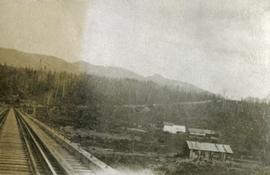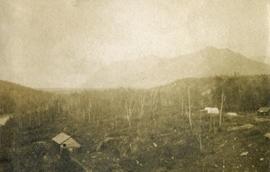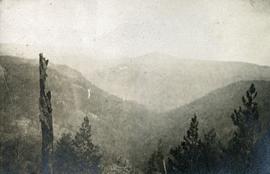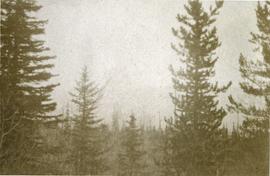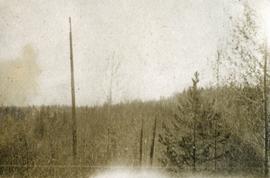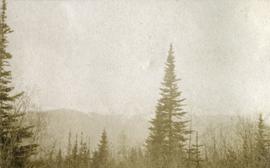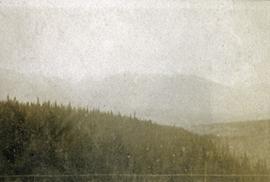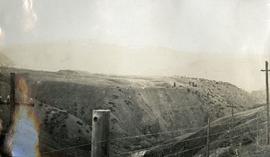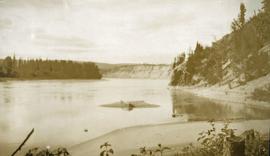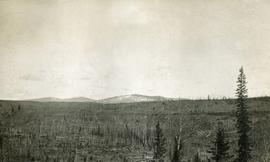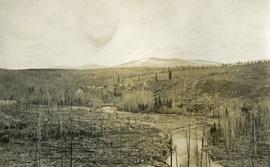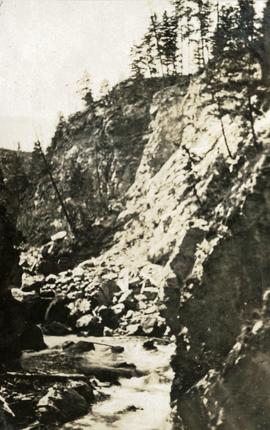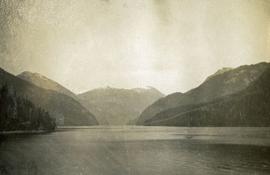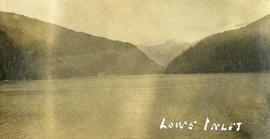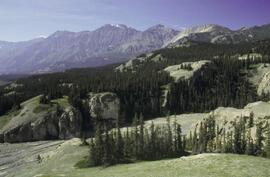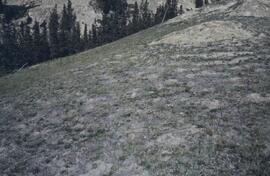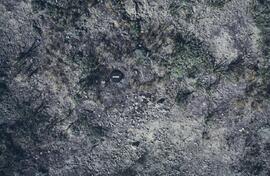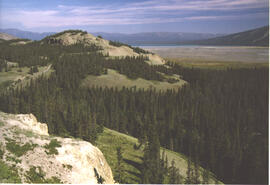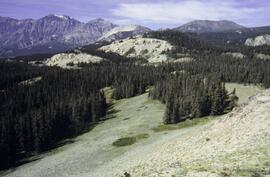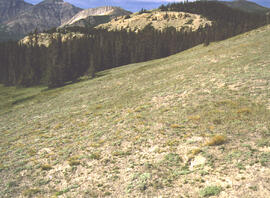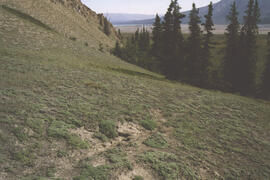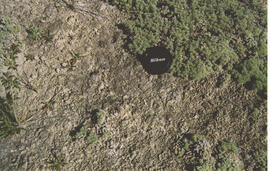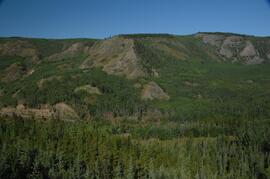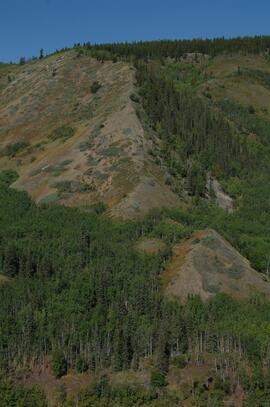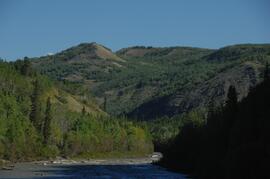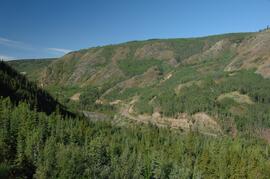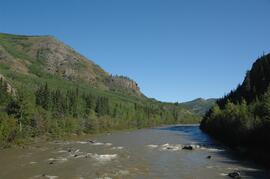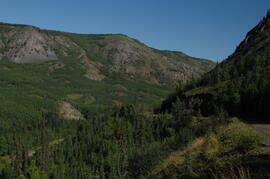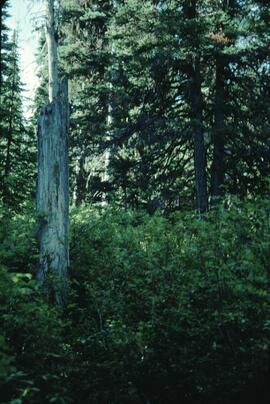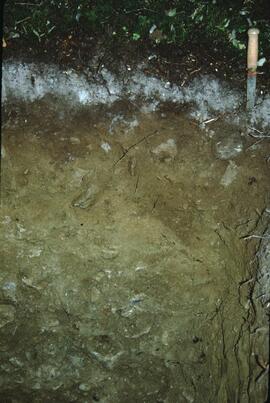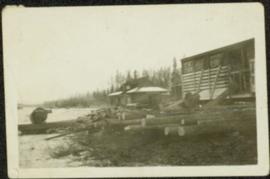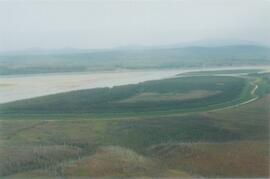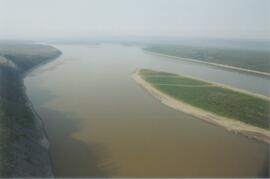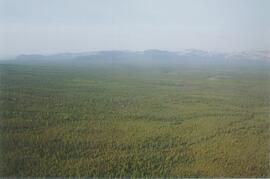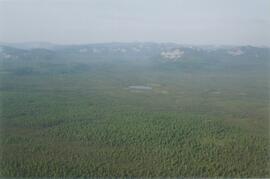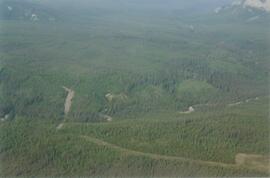Photograph depicts looking down a railroad track on the left, a few scattered shanties in the right foreground, freshly cleared land, forest and a mountain range in the distance.
Photograph depicts newly cleared land with three or more buildings. Forest and mountains in the background.
Photograph depicts a view of a forested mountain valley, looking toward a peak.
Photograph depicts tree tops and sky.
Photograph depicts a view past tree tops to a snow capped mountain range.
Photograph depicts a view past tree tops to a snow capped mountain range.
Photograph depicts looking beyond a treed mountain ridge to snow capped mountains in the distance.
Photograph depicts rolling hills with dry vegetation and river in the background.
Photograph depicts river and high river bank in the distance.
Item consists of second part of the panel on "Looking to the Past to Inform the Future? Forest History within a Contemporary Context" at the the "Exploring Our Roots: Forest History in Our Communities Annual Conference of the Forest History Association of BC" at UNBC in Prince George, September 19, 2009.
Photograph depicts a view of sparsely forested rolling hills with low mountains in the background.
Photograph depicts a view of sparsely forested hillsides with a creek in the center of the photo, low mountains in the background.
Photograph depicts a stream of water, a steep canyon wall in the background.
Photograph depicts of Lowe Inlet BC from the water looking toward the mountains.
Photograph depicts a view from the water of Lowe Inlet.
File consists of issues of the "LTSPS: Research Note" Prince George, Prince Rupert and Cariboo Forest Regions LTSPS-03 and LTSPS-04 (March, 2000) and "Forest: Research Note" Prince George Forest Region: Forest Resources and Practices Team PG-22 and PG-23 (March, 2000).
This born-digital "Lucille Mountain soils" document provides a description and basic data for the Lucille Mt. pedon.
Photograph depicts pile of cut logs in right foreground, unknown building and forest in background. Logs lie in front of what appears to be a large freight box.
Sub-subseries consists of records relating to the beginnings of the softwood lumber dispute, commonly referred to as Lumber I. In 1982, when the U.S. lumber industry petitioned the U.S. Department of Commerce (DoC) to impose a countervailing duty. Ultimately, the DoC found that Canada's stumpage system was not specific to any single industry and thus not countervailable. While the DoC made this claim, the United States International Trade Commission (USITC) believed that these Canadian imports did in fact hinder U.S. producers. The U.S. lumber industry chose not to appeal.
Zimmerman, AdamFile contains clippings and newspaper articles regarding the softwood lumber dispute.
Zimmerman, AdamFile contains several bound copies of US legislation pertaining to the Canada/US softwood lumber trade dispute.
Zimmerman, AdamSub-subseries consists of records relating to the second phase of the Canada-U.S. Softwood Lumber Dispute, commonly referred to as Lumber II. In 1986, a U.S. lumber industry group, the Coalition for Fair Lumber Imports, petitioned the Department of Commerce (DoC). The United States International Trade Commission (USITC) once again arrived at the conclusion that Canada's exports unfairly impacted American producers. This time, the DoC did find Canadian forest programs to be countervailable and set a preliminary duty of 15%. Before the subsidy was imposed, the United States and Canada agreed to a Memorandum of Understanding that created a phased tariff. One of the terms of the MOU was that Canada levy an export tax on lumber traveling to the United States. Provinces that were affected had the chance to reduce this tax, if they performed any action meant to counterbalance their subsidies. British Columbia had the tax removed in 1987 while Quebec had it partly lifted in 1988.
Zimmerman, AdamFile contains clippings and newspaper articles regarding the softwood lumber dispute.
Zimmerman, AdamFile contains correspondence and other material concerning trade with the US.
Zimmerman, AdamFile contains the "Testimony on U.S. Trade Policy and Unfair Trade Practices" by Ambassador Clayton Yeutter, United States Trade Representative, before the Committee on Finance, United States Senate, November 14, 1985.
Zimmerman, AdamSub-subseries consists of records relating to the third phase of the Canada-U.S. Softwood Lumber Dispute, commonly referred to as Lumber III. In 1991, Canada informed the United States it was withdrawing from the Lumber II Memorandum of Understanding. In response, the Department of Commerce (DoC) initiated a countervailing duty investigation, resulting in the DoC imposing countervailing duties. This time, the Department of Commerce's determination was reviewed by a binational panel organized under the Canada-U.S. Free Trade Agreement (CUSFTA). The panel found that the DoC's determination could not be supported by substantial evidence. In 1996, the United States and Canada reached a five-year trade agreement, The Softwood Lumber Agreement, officially ending Lumber III.
Zimmerman, AdamFile contains correspondence and other material concerning trade with the US.
Zimmerman, AdamFile contains various correspondence regarding 1964 annual cuts for sawmills in the area, memoranda consisting of various administrative issues such as the 1973 amalgamation of Purden Lake and Aleza Lake, and the sale of lumber previously infested by spruce beetles. File also contains 1972 applications to purchase Crown timber and road use, as well as 1966 logging permits.
The eastern flank of the Mackenzie Mountains has a complex history of multiple glaciations by both the Laurentide and Cordilleran ice sheets, recorded in thick sequences of glacial sediments that were documented at 3 locations (Katherine Creek, Little Bear River, Inlin Brook) by:
Duk-Rodkin, A., R.W. Barendregt, C. Tarnocai, and F.M. Phillips. 1996. Late Tertiary to late Quaternary record in the Mackenzie Mountains, Northwest Territories, Canada: stratigraphy, paleosols, paleomagnetism, and chlorine-36. Canadian Journal of Earth Sciences 33 (6): 875-895. https://doi.org/10.1139/e96-066
Of the 3 sites, the exposure on Inlin Brook, a tributary of the Keele River, was the least well-documented, so in summer 2004 Dr. Paul Sanborn joined a field party of the Geological Survey of Canada (GSC) based at Tulita, NWT, and was given helicopter support to visit Inlin Brook (August 5-8). A brief visit was also made to the Little Bear River site.
On August 9-10, Sanborn joined Alejandra Duk-Rodkin (GSC) and Rene Barendregt (U Lethbridge) in helicopter-assisted field work at sites in the Franklin Mountains and elsewhere east of the Mackenzie River.
Photograph depicts the Mackenzie Valley and the Franklin Mountains. Pipeline is visible.
